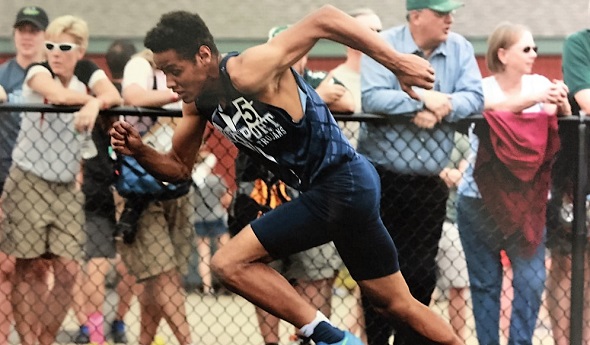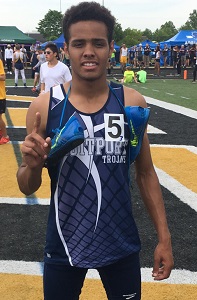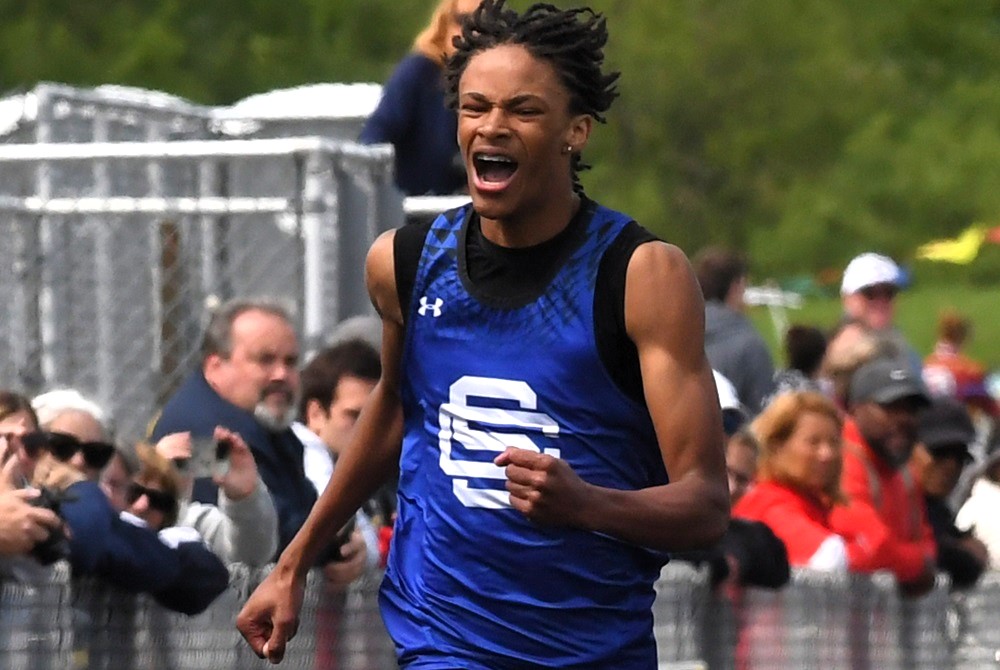
Fruitport's Oleen Catches Up Quickly
April 12, 2018
By Tom Kendra
Special for Second Half
Cameron Oleen first ran track his sophomore year.
 As a junior last spring, he was the 400-meter champion at the MHSAA Lower Peninsula Division 2 Finals.
As a junior last spring, he was the 400-meter champion at the MHSAA Lower Peninsula Division 2 Finals.
While pulling off that feat is certainly a testament to the Fruitport High School senior’s talent, work ethic and determination, it also illustrates Oleen’s potential as he gains more experience on the track.
“Cam is still learning – that’s the exciting part,” said 15th-year Fruitport boys track coach Chad Brandow, wearing his winter coat and gloves during a recent practice. “He is a state champion who is still very raw. To be honest with you, Cam is one of the main reasons I’m still out here. I was gonna hang it up a couple years ago, but I want to be here to see what this kid can do.”
What Oleen wants to do is add two more Finals titles before starting his collegiate running career at Michigan State University, where he has verbally committed to attend as a preferred walk-on.
He already has two titles under his belt. The first came that sophomore year, when he ran a leg on Fruitport’s winning 3,200-meter relay, teaming with Kody Brooks, Seth Glover and Noah Hendricks for a winning time of 7:54.39. Then came last year’s shocking victory in the 400, when he dove at the tape to win with a personal-best time of 49.21.
“If you asked me last year if I could win state in the 400, I would have said no way,” said Oleen, who also runs cross country and plays basketball at Fruitport. “But when we were approaching the final turn, with about 150 meters left, I realized that I could win and be a state champion. That was kind of a turning point for me.”
As is often the case for Oleen in big races, he was trailing multiple runners nearing the end, including neighboring rival Isaiah Pierce of Spring Lake. But Oleen, motivated by Fruitport’s disappointing seventh-place finish in the 3,200-meter relay earlier in the day, kicked on the after-burners and won in a photo finish.
“The last 100 meters, I couldn’t feel my legs, so I just ran with my heart the whole way,” explained Oleen.
His goal for this spring is to pull off a rare double at the MHSAA Division 2 Finals on June 2 at Zeeland - repeat as champion in the 400, then come back just two events later and win the 800.
It’s a daunting (and tiring) goal, but Brandow said if there is anyone who can do it, it’s Oleen.
“He doesn’t get tired,” said Brandow, who is in his 30th year coaching track, with previous stops at Muskegon Heights and Muskegon High. “Cam will do the sprint workouts with the sprinters and then turn around and do the distance workouts right after. He always works hard. He could pull it off.”
Both Brandow and Fruitport cross country coach Randy Johnson rave about Oleen’s God-given running ability and untapped potential, but they also emphasize that he is a great leader, role model and the ultimate teammate – even when individual opportunities might be at stake.
 The best example of that came at the MHSAA LP Division 2 Cross Country Finals his junior year, when Oleen was on pace for a top-30 finish and all-state with less than a quarter-mile to go.
The best example of that came at the MHSAA LP Division 2 Cross Country Finals his junior year, when Oleen was on pace for a top-30 finish and all-state with less than a quarter-mile to go.
He stopped to help teammate Mitchell Johnson, who was struggling with exhaustion. The teammates ended up walking the final 400 meters together, with Johnson placing 46th and Oleen 47th.
“It was just a natural reaction for me to stop and see how Mitch was doing,” explained Oleen, who came back to earn all-state honors in cross country last fall with a 13th-place finish. “I would do the same thing again. Our coaches teach us that the team is everything.”
Now that he is a senior, Oleen has assumed a leadership role on the team and is trying to provide a good example like 2017 graduates Johnson and Aaron Simot and others provided for him. He even refers to his past and present Fruitport teammates as family, whom he said have helped him through so much both on and off the track.
“One thing that might surprise you about me is that I really don’t like running by myself, especially more than two miles,” said Oleen, the son of Bill and Joy Oleen, with a laugh. “But when I’m out here running with my family, it’s totally different. I forget about it. Any success I’ve had, these people out here are a big part of it.”
Oleen is determined to make the most of his final couple of months with his Fruitport track family. He just returned from a spring break trip to Myrtle Beach, S.C., with 18 team members, and now the Trojans are aiming for a fifth straight Greater Muskegon Athletic Association city meet title. Then the focus will shift to Ottawa-Kent Conference Black, Regional and state goals.
Looking ahead to college, Oleen plans to major in kinesiology and become an invested part of both the cross country and track families at MSU, where he could see his main events becoming the 800 and the 1,600. Brandow sees another possibility for his star pupil’s future.
“With his athletic ability, they could put him in the steeplechase,” Brandow said.
Fruitport already has one steeplechase legend in 1995 graduate Tom Chorny, a collegiate star at Indiana University who went on to win the 2001 U.S. Championship in the 3,000-meter steeplechase. Chorny, a 2017 inductee into the Muskegon Area Sports Hall of Fame, is now the head track and cross country coach at Miami University (Ohio).
Oleen is approaching his running future with an open mind. After all, less than a year ago, he couldn’t imagine being an individual Finals champion – but that breakthrough win whetted his appetite and now his eyes are wide open.
“I need to have goals to drive me,” Oleen said. “That’s why I put it out there to try and win the 400 and 800 at state, to drive me. I’ve got a bunch of goals in my head for college, too. Then I want to shoot for the 2028 Olympic Games.”
 Tom Kendra worked 23 years at The Muskegon Chronicle, including five as assistant sports editor and the final six as sports editor through 2011. E-mail him at [email protected] with story ideas for Muskegon, Oceana, Mason, Lake, Oceola, Mecosta and Newaygo counties.
Tom Kendra worked 23 years at The Muskegon Chronicle, including five as assistant sports editor and the final six as sports editor through 2011. E-mail him at [email protected] with story ideas for Muskegon, Oceana, Mason, Lake, Oceola, Mecosta and Newaygo counties.
PHOTOS: (Top) Cameron Oleen hits stride during a race last season. (Middle) Oleen after winning his first individual MHSAA Finals championship in 2017. (Photos courtesy of the Fruitport athletic department.)

Performance of the Week: Southfield Christian's Brock Morris
June 5, 2025
 Brock Morris ♦ Southfield Christian
Brock Morris ♦ Southfield Christian
Senior ♦ Track & Field
Morris finished an individually-phenomenal day at Saturday's Lower Peninsula Division 4 Finals by helping his teammates make school history. With Southfield Christian trailing leader Kalamazoo Hackett Catholic Prep by three points heading into the final event of the day, Morris anchored the Eagles' 1,600 relay and crossed the finish line first – which, combined with Hackett's third-place finish in the race, gave Morris and his teammates their school's first Finals team championship in track & field by one point.
That victory capped a day that also saw Morris win the 200 and 400-meter open races and run on the winning 800 relay as well. Morris was part of school records in all four of those races this season and the 400 relay as well; the 1,600 relay time of 3:24.36 on Saturday lowered that school record and also included Dylan Taylor-Wilkerson, Robert Brown and Jadon Staten. Morris also ran cross country and played point guard on the boys basketball team. He will study at University of Michigan, majoring in biology, health and society on a pre-medical track.
@mhsaasports 🏃♂️POW: Brock Morris #southfieldchristian #track #finals #winner #1600relay #anchor #part1 #highschoolsports #tiktalk #interview #performanceoftheweek #mistudentaid #fyp #MHSAA ♬ original sound - MHSAA
@mhsaasports 🏃♂️POW: Brock Morris #instagram #chocolatemilk #hidden #talent #emoji #part2 #performanceoftheweek #mistudentaid #fyp #MHSAA ♬ Monkeys Spinning Monkeys - Kevin MacLeod & Kevin The Monkey
Follow the MHSAA on TikTok.
MHSAA.com's "Performance of the Week" features are powered by MI Student Aid, a division within the Department of Lifelong Education, Advancement, and Potential (MiLEAP). MI Student Aid encourages students to pursue postsecondary education by providing access to student financial resources and information. MI Student Aid administers the state’s 529 college savings programs (MET/MESP), as well as scholarship and grant programs that help make college Accessible, Affordable and Attainable for you. Connect with MI Student Aid at www.michigan.gov/mistudentaid and find more information on Facebook and Twitter @mistudentaid.
Previous 2024-25 honorees
May 30: Chloe Qin, Bloomfield Hills Cranbrook Kingswood tennis - Report
May 23: Drew Goik, Bay City Western golf - Report
May 15: Sydney Kuhn, Saginaw Swan Valley track & field - Report
May 8: Ryan Bosch, Fruitport baseball - Report
May 1: Jackson Lam, Kalamazoo Loy Norrix track & field - Report
April 25: Isabelle Horvath, Bangor softball - Report
April 18: Presley Jones, Sterling Heights Stevenson soccer - Report
April 11: Olivia Jasniewicz, Troy soccer - Report
March 27: Katie Spicer, Fowler basketball - Report
March 21: Moses & Markus Blackwell; Warren Lincoln basketball - Report
March 13: Keyshawn Summerville, Lansing Sexton basketball - Report
March 6: Maggie Buurma, Fowlerville wrestling - Report
Feb. 28: Maren Studt, Pontiac Notre Dame Prep skiing - Report
Feb. 21: Olive Krueger, Marquette swimming - Report
Feb. 14: Hunter Lemmon, Fraser swimming - Report
Feb. 7: Aubrey Hillard, Rochester competitive cheer - Report
Jan. 31: Wyatt Spalo, Reed City wrestling - Report
Jan. 24: Olivia Flynn, Harbor Springs basketball - Report
Jan. 17: Levi Rozema, Holland Christian swimming - Report
Jan. 10: McRecco McFadden, Burton Bentley basketball - Report
Dec. 18: Nash Leonard, Bay City Western hockey - Report
Dec. 11: Blake Cosby, Dundee wrestling - Report
Dec. 4: Keaton Hendricks, Zeeland West football - Report
Nov. 29: Kate Simon, East Grand Rapids swimming - Report
Nov. 22: Ella Kokaly, Essexville Garber volleyball - Report
Nov. 15: Caroline Bryan, Grosse Pointe South swimming - Report
Nov. 8: Kaylie Livingston, Whitmore Lake cross country - Report
Oct. 25: Oliver Caldwell, Grand Rapids West Catholic tennis - Report
Oct. 18: Alex Graham, Detroit Cass Tech football - Report
Oct. 11: Victoria Garces, Midland Dow cross country - Report
Oct. 4: Asher Clark, Bay City John Glenn soccer - Report
Sept. 26: Campbell Flynn, Farmington Hills Mercy volleyball - Report
Sept. 19: TJ Hansen, Freeland cross country - Report
Sept. 12: Jordan Peters, Grayling soccer - Report
Sept. 6: Gabe Litzner, Sault Ste. Marie cross country - Report
Aug. 30: Grace Slocum, Traverse City St. Francis golf - Report
(Photo by RunMichigan.com.)

